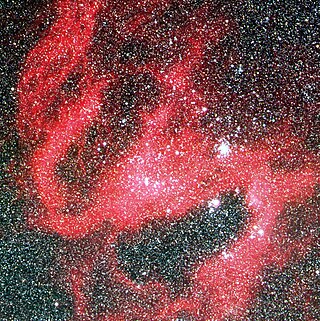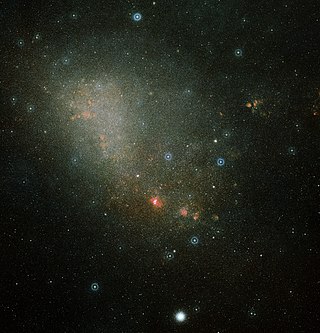Related Research Articles

Red supergiants (RSGs) are stars with a supergiant luminosity class of spectral type K or M. They are the largest stars in the universe in terms of volume, although they are not the most massive or luminous. Betelgeuse and Antares A are the brightest and best known red supergiants (RSGs), indeed the only first magnitude red supergiant stars.

S Doradus is one of the brightest stars in the Large Magellanic Cloud (LMC), a satellite galaxy of the Milky Way, located roughly 160,000 light-years away. The star is a luminous blue variable, and one of the most luminous stars known, having a luminosity varying widely above and below 1,000,000 times the luminosity of the Sun, although it is too far away to be seen with the naked eye.

Phi Cassiopeiae is a star in the constellation Cassiopeia. φ Cassiopeiae is a multiple star with a combined apparent magnitude of +4.95. The two brightest components are A and C, sometimes called φ1 and φ2 Cas. φ Cas A is an F0 bright supergiant of magnitude 4.95 and φ Cas C is a 7.08 magnitude B6 supergiant at 134".

NO Aurigae is a pulsating variable star in the constellation Auriga. It is an unusually-luminous asymptotic giant branch star about 3,500 light years away.

WOH G64 is an unusual red supergiant (RSG) star in the Large Magellanic Cloud (LMC) satellite galaxy in the southern constellation of Dorado. It is one of the largest known stars, being described as possibly being the largest star known. It is also one of the most luminous and massive red supergiants, with a radius calculated to be around 1,540 times that of the Sun (R☉) and a luminosity around 282,000 times the solar luminosity (L☉).

A hypergiant (luminosity class 0 or Ia+) is a very rare type of star that has an extremely high luminosity, mass, size and mass loss because of its extreme stellar winds. The term hypergiant is defined as luminosity class 0 (zero) in the MKK system. However, this is rarely seen in literature or in published spectral classifications, except for specific well-defined groups such as the yellow hypergiants, RSG (red supergiants), or blue B(e) supergiants with emission spectra. More commonly, hypergiants are classed as Ia-0 or Ia+, but red supergiants are rarely assigned these spectral classifications. Astronomers are interested in these stars because they relate to understanding stellar evolution, especially star formation, stability, and their expected demise as supernovae.

Melnick 42 is a massive blue supergiant star in the Tarantula Nebula in the Large Magellanic Cloud located in the constellation Dorado. Although it is only 21 times the size of the sun, its high temperature of 47,300 K makes it one of the most luminous stars of the Tarantula Nebula at 3,600,000 L☉. It is less than two parsecs from the centre of the R136 cluster, although that is well outside the central core.

HD 33579 is a white/yellow hypergiant and one of the brightest stars in the Large Magellanic Cloud (LMC). It is a suspected variable star.

HV 2112 is a cool luminous variable star in the Small Magellanic Cloud. Until 2018, it was considered to be the most likely candidate for a Thorne–Żytkow object, but it is now thought to be an asymptotic giant branch star.
BAT99-98 is a star in the Large Magellanic Cloud. It is located near the R136 cluster in the 30 Doradus nebula. At 226 M☉ and 5,000,000 L☉ it is one of the most massive and luminous stars known.

HV 11423 is a red supergiant star in the Small Magellanic Cloud. It is about 200,000 light-years away towards the constellation of Tucana.

R71 is a star in the Large Magellanic Cloud (LMC) in the constellation Mensa. It is classified as a luminous blue variable and is one of the most luminous stars in the LMC. It lies three arc-minutes southwest of the naked-eye star β Mensae.

HV 888, also known as WOH S140, is a red supergiant (RSG) star located in the Large Magellanic Cloud. It is among the largest known stars, with estimates of its radius ranging from 765 R☉ to over 1,700 R☉, and is also one of the most luminous of its type with a range of nearly 300,000 to over 500,000 times that of the Sun (L☉). The effective temperature is estimated to be around 3,500 K. If placed at the center of the Solar System, its photosphere would engulf the orbit of Jupiter and possibly even Saturn.
WOH S279 is a red supergiant located in the constellation of Dorado. It is currently among the largest known stars with an radius of about 1,300 solar radii. If placed at the center of the solar system, its photosphere would engulf the orbit of Jupiter.
SP77 46-44 is a red supergiant star found in the Large Magellanic Cloud in the constellation of Dorado. It is one of the largest stars discovered, with a radius over 1,200 solar radii. If placed in the Solar System, its photosphere would engulf the orbit of Jupiter.

WOH S264 is a large, highly luminous red supergiant star in the Large Magellanic Cloud.

V1027 Cygni is a luminous yellow supergiant star located in the constellation of Cygnus, about 14,000 light years away. For a time, it was thought that it could be a low-mass post-AGB star, however recent parallax measurements published in Gaia DR3 have shown this to likely not be the case, and instead it is likely a massive yellow supergiant star.
References
- 1 2 3 4 5 6 Vallenari, A.; et al. (Gaia Collaboration) (2022). "Gaia Data Release 3. Summary of the content and survey properties". Astronomy & Astrophysics . arXiv: 2208.00211 . doi: 10.1051/0004-6361/202243940 . Gaia DR3 record for this source at VizieR.
- ↑ Henden, Arne A.; Levine, Stephen; Terrell, Dirk; Welch, Douglas L. (2015). "APASS - the Latest Data Release". American Astronomical Society Meeting Abstracts #225. 225: 336.16. Bibcode:2015AAS...22533616H.
- 1 2 Kastner, Joel H.; Thorndike, Stephen L.; Romanczyk, Paul A.; Buchanan, Catherine L.; Hrivnak, Bruce J.; Sahai, Raghvendra; Egan, Michael (2008). "The Large Magellanic Cloud's Top 250: Classification of the Most Luminous Compact 8 μm Sources in the Large Magellanic Cloud". The Astronomical Journal. 136 (3): 1221–1241. arXiv: astro-ph/0703584 . Bibcode:2008AJ....136.1221K. doi:10.1088/0004-6256/136/3/1221. S2CID 117820349.
- ↑ Westerlund, B. E.; Olander, N.; Hedin, B. (1981). "Supergiant and giant M type stars in the Large Magellanic Cloud". Astronomy and Astrophysics Supplement Series. 43: 267. Bibcode:1981A&AS...43..267W.
- ↑ Kordopatis, G.; Gilmore, G.; Steinmetz, M.; Boeche, C.; Seabroke, G. M.; Siebert, A.; Zwitter, T.; Binney, J.; De Laverny, P.; Recio-Blanco, A.; Williams, M. E. K.; Piffl, T.; Enke, H.; Roeser, S.; Bijaoui, A.; Wyse, R. F. G.; Freeman, K.; Munari, U.; Carrillo, I.; Anguiano, B.; Burton, D.; Campbell, R.; Cass, C. J. P.; Fiegert, K.; Hartley, M.; Parker, Q. A.; Reid, W.; Ritter, A.; Russell, K. S.; et al. (2013). "The Radial Velocity Experiment (RAVE): Fourth Data Release". The Astronomical Journal. 146 (5): 134. arXiv: 1309.4284 . Bibcode:2013AJ....146..134K. doi:10.1088/0004-6256/146/5/134. S2CID 119221010.
- 1 2 3 4 5 Groenewegen, Martin A. T.; Sloan, Greg C. (2018). "Luminosities and mass-loss rates of Local Group AGB stars and Red Supergiants". Astronomy & Astrophysics. 609: A114. arXiv: 1711.07803 . Bibcode:2018A&A...609A.114G. doi:10.1051/0004-6361/201731089. ISSN 0004-6361. S2CID 59327105.